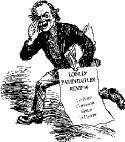
 |
 |

| Thursday, April 25, 2024 |
Miles from the Mainstream |
D.
R. ZUKERMAN, proprietor |
On the Origins of Obamaism
May 4, 2013 -- To a great extent, it is Henry A. Wallace, not Saul Alinsky, stupid. LPR does not doubt that President Obama was influenced by the polarizing tactics of leftist militant Alinsky, but "community organizing" is not a laboratory for national governance. Conservatives would do well to understand President Obama by paying attention to Henry A. Wallace, vice president during President Franklin D. Roosevelt's third term, secretary of agriculture prior to that term and secretary of commerce for some 20 months after FDR's election to a fourth term. Wallace was forced to leave his commerce post after he spoke out, September 12, 1946, opposing a strong foreign policy vis-a-vis the Soviet Union. By September 1946, Stalin had made it clear that the Soviet Union would not tolerate free democracies in eastern Europe. Wallace declared: "Getting tough never bought anything real and lasting -- whether for schoolyard bullies or businessmen or world powers. The tougher we get, the tougher the Russians will get." For George F. Kennan, Wallace represented diplomacy "'by the glad hand and the winning smile.'" Kennan saw nothing to gain by this approach, as John Lewis Gaddis makes clear in his biography of Kennan, longtime state department official, ambassador, foreign policy expert. LPR sees President Obama as following the Wallace approach of eschewing a tough stance toward international adversaries, applying, instead, "the glad hand and the winning smile." Wallace dropped his "glad hand" and "winning smile" when he referred to domestic adversaries --sharply denouncing businessmen and Republicans. In the domestic arena, too, President Obama is very much a Wallaceite. |
On economic matters, President Obama has been apparently influenced by the "Plan and Spend" theorists of the 1930's who claimed that "government debt is not like private debt" and called for massive government spending. John T. Flynn, in The Roosevelt Myth (1948) summarized this economic view: "The debt is due by the people to themselves. The people owe the debt. The government taxes the people to pay the interest on [government] bonds. It takes the taxes out of the pockets of the people and then pays it back to them in the form of interest. It is just taking out of one pocket and putting it in the other." Anyone doubting the ongoing vitality of this view should see Paul Krugman's New York Times column, January 1, 2012. (Among other things, Krugman argues that government debt is simply money we owe ourselves.) Flynn cited one economist from Harvard who thought that "that over the course of years the government might create a debt of a thousand billion dollars without being unduly worried." Flynn commented:: "a more crack-brained proposition was never promulgated in the name of higher learning." LPR would note that "a thousand billion dollars" are known, these days, as a trillion dollars. Perhaps the practitioners of Obamanomics would argue that if government debt of a trillion dollars was acceptable in 1936 or 1937, government debt of 17 trillion dollars, or more -- allowing for some 75 years of inflation -- is certainly no cause for concern in 2013. |
|
